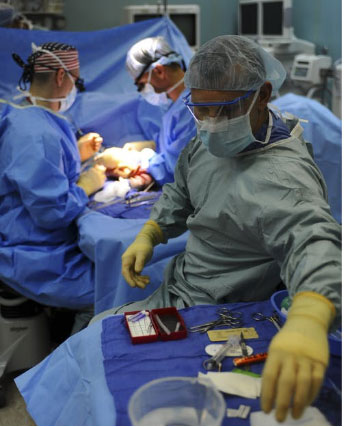4 Reasons Why the Healthcare Industry in the US is Declining

Did you know that only 7% of American residents have a positive outlook on the healthcare ndustry?
Although the US has taken extensive measures to upgrade its healthcare system and offer a better patient experience, there’s still a lot of room for change.
As suggested by the Gallup poll the public perception of the healthcare system is mostly negative. Even many political affiliations agree that the healthcare industry requires change.
The President of the Commonwealth fund said that the US is in a state of crisis consistently for 20 years, even though it invests a lot in its healthcare system.
The Commonwealth Fund ranks developed countries over their healthcare systems. However, the US never made its way to the list of best countries. Let’s find out why.
Patient Satisfaction
Patients are only satisfied when they’re getting value for the price they pay. Whereas, the healthcare system in the US is one of the most expensive, yet its performance in terms of patient care is underwhelming.
Although patient-centered care is ranked high, the overall quality of care is not up to the mark for the following reasons.
Minor Medical Errors
A study analyzed the death ratio in the US for the past eight years and concluded that 250,000 deaths occur every year due to minor medical errors. This accumulates to 10% of all US deaths.
After cancer and heart disease, this has become one of the major causes of death and has posed a serious threat to the healthcare industry.
Ineffective Care System
An inefficient and obstructed system has been one of the biggest loopholes in the US healthcare industry, and the reason why it’s ranked the lowest on the HAQ Index for amenable mortality.
This index measures the responsiveness and timely care of premature and preventable deaths.
Cover-ups For Mistakes
The US healthcare system is often criticized for its lack of transparency, as well as cover-ups and fraud regarding insurance policies. Policyholders are stuck in between the ‘upcoding’ problem.
Providers ‘upcode’ to pull out more money from insurance companies, similarly, insurance companies charge higher premiums from the policyholders but fasten their belts when it comes to paying for them.
Neither does the patient have the power to control the outcome of the treatment, nor does the pricing.

Unavailability of Doctors
More than often, the best doctors are unavailable because they’re preoccupied. At times, the patient is unable to reach out to specialists, and even if they do, they get an appointment after ages.
Another reason could be the unavailability of information regarding doctors’ skills and credentials. Being unaware of the healthcare industry might cost you a lot.
Increasing Expenditures
The annual report data from the Health Cost Institute indicates the consistent spike in healthcare costs every passing year. In 2018, 10% of the GDP was spent on the healthcare system by the companies and residents. Ever since that, the number has only increased.
The CMS Office of the actuary predicts that the increasing cost of the US healthcare system will outweigh the GDP growth rate in the upcoming years.
$3.8 trillion has been spent on the healthcare industry in 2019 and is said to double in the next 10 years, accounting for more than 19% of the GDP.
High Cost of C-section
Just the admission price for a C-section in the US amounts to $15,000. This is the highest cost for C-section as compared to any other country.
Apart from normal child-birth delivery. Almost every other procedure like knee replacement, bypass surgery, angioplasty, etc. costs 50% higher in the US.
Demand for New Technology
The cost of healthcare services has risen due to the need for resources. Advanced systems require training or experienced personnel to manage the new operations.

Prescription Drugs and Diagnostics Tests
More than 16% of personal healthcare expenditure comprises drug prescriptions. According to the U.S Department of Health and Human Services, it topped $457 billion in 2015.
Not only are the medicines expensive, but the cost of diagnostic testing is also costly. The general practitioners prescribe plenty of tests due to the fear of being sued for the wrong treatment.
No Insurance Coverage
Since the insurance policies are costly, most Americans remain uninsured. A report suggests that uninsured residents are hesitant to seek professional doctor consultation and prescription because they won’t be able to pay expenses on their own without insurance coverage.
This has adverse effects on the health of people since they miss out on regular health check-ups and preventive care.
Shortage of Doctors
The supply and demand ratio of the doctor vs patient poses a threat of shortage and inefficiencies in the healthcare system.
The Data recorded by AAMC predicts that the US will face a shortage of general practitioners due to a boost in demand by 2033.
The findings also suggest that either the best doctors will reach their retirement age in less than 10 years, or many will be forced to retire sooner due to physical burnout.
Even the ones who’re present to look after the patients won’t be able to accommodate everyone in the given timeframe.

Improving Healthcare in the US
Not only have technological advancements made communication networks stronger around the world, but they have also made things easier for the healthcare industry.
The rise of telehealth services focuses on patient empowerment. The patient can easily book a doctor’s appointment online and get the required drug prescription.
Reduce costs
Keeping in mind the extensive waiting hours and travel expenses, telemedicine has reduced the overall expenses of patients.
Increase in Transparency
Since the patient is communicating from the comfort of their home, they are more inclined to be educated on their health issues. They are aware of the prescribed drugs they’re consuming.
Increase in Efficiency
Previously, you couldn’t reach out to any specialist before an appointment or on call, but telehealth services have made it easier for patients to access any kind of specialist at any time just through a call or online video consultation.
Medical Facility for People Without Insurance
Telemedicine has made lives much easier by offering medical facilities, even to those who don’t have medical insurance.
Many healthcare facilities offer online doctor consultation services without health insurance.
Reduced Workplace Expenses
Telehealth service providers benefit in terms of reduced expenses. In-person appointments may require front desk support costs along with investment inside office space.
High Patient Care
When patients are connected to the doctor from the comfort of their homes, they seem more relaxed and attentive. Even doctors can accommodate their patients better when offered the right headspace to function properly.
TelMDCare offers insurance-free online medical consultations and provides urgent care online at a flat rate which includes a complimentary follow-up. Book a virtual doctor consultation by visiting our website today!
Disclaimer: This article is solely for information purposes and doesn’t intend to serve as medical advice. If you have any questions about your medical health, you should consult with a qualified health professional.